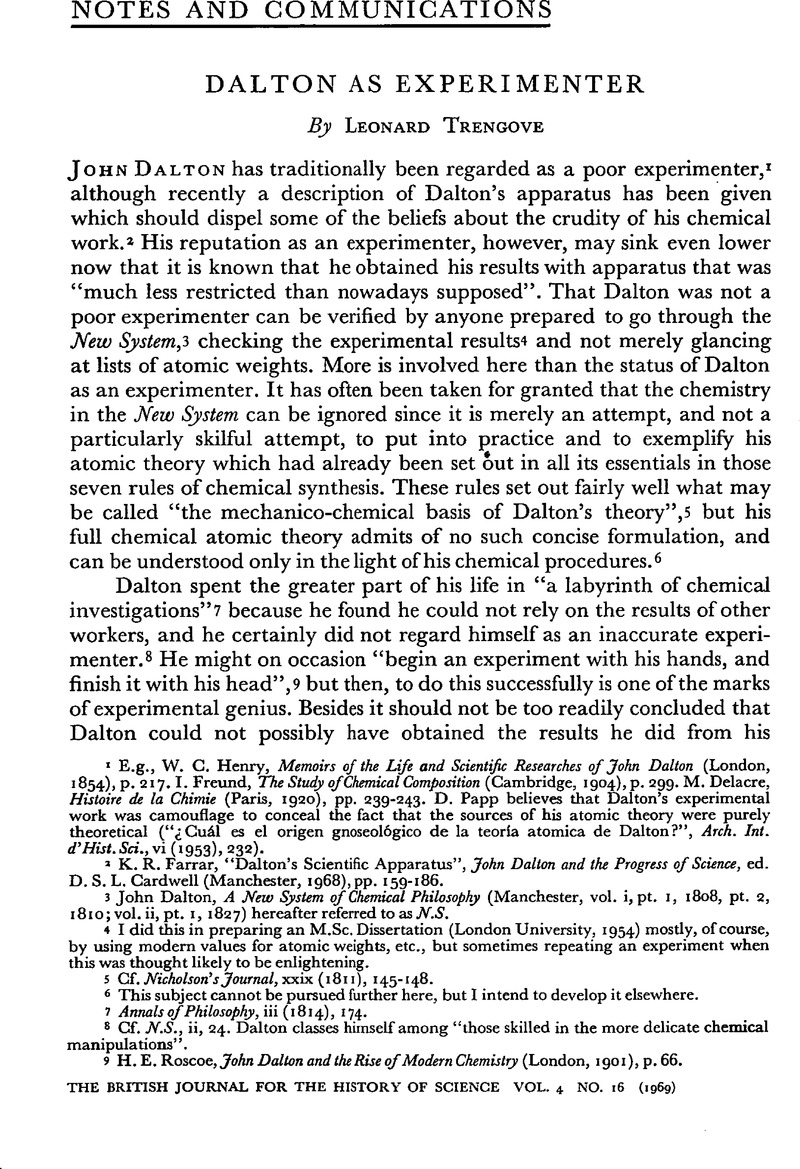Published online by Cambridge University Press: 05 January 2009

1 E.g., Henry, W. C., Memoirs of the Life and Scientific Researches of John Dalton (London, 1854), p. 217Google Scholar. Freund, I., The Study of Chemical Composition (Cambridge, 1904), p. 299Google Scholar. Delacre, M., Histoire de la Chimie (Paris, 1920), pp. 239–243Google Scholar. D. Papp believes that Dalton's experimental work was camouflage to conceal the fact that the sources of his atomic theory were purely theoretical (“؟Cuál es el origen gnoseológico de la teoría atomica de Dalton?”, Arch. Int. d'Hist. Sci., vi (1953), 232).Google Scholar
2 Farrar, K. R., “Dalton's Scientific Apparatus”, John Dalton and the Progress of Science, ed. Cardwell, D. S. L. (Manchester, 1968), pp. 159–186.Google Scholar
3 Dalton, John, A New System of Chemical Philosophy (Manchester, vol. i, pt. 1, 1808, pt. 2, 1810Google Scholar; vol. ii, pt. 1, 1827) hereafter referred to as N.S.
4 I did this in preparing an M.Sc. Dissertation (London University, 1954) mostly, of course, by using modern values for atomic weights, etc., but sometimes repeating an experiment when this was thought likely to be enlightening.
5 Cf. Nicholson's Journal, xxix (1811), 145–148.Google Scholar
6 This subject cannot be pursued further here, but I intend to develop it elsewhere.
7 Annals of Philosophy, iii (1814), 174.Google Scholar
8 Cf. N.S., ii, 24Google Scholar. Dalton classes himself among “those skilled in the more delicate chemical manipulations”.
9 Roscoe, H. E., John Dalton and the Rise of Modern Chemistry (London, 1901), p. 66.Google Scholar
10 N.S., vol. i, pt. 2, preface.Google Scholar
11 Quart. Rev., xcvi (1854–1855), 47.Google Scholar
12 Free Evening Lectures. South Kensington Museum, London, 1876, Lecture I. H. E. Roscoe, “On John Dalton's apparatus and what he did with it,” pp. 13, 14. Memoirs Manchester Lit. and Phil. Soc., i (1805), 244.Google Scholar
13 Nothing is implied here about the correctness of Meldrum's views about the origin of Dalton's atomic theory.
14 Henry, W. C., op. cit. (1), p. 169.Google Scholar
15 Ibid., p. 179.
16 N.S., i, 61, 62Google Scholar. Actually the list he gave was that of Wilcke and Crawford, but this differed little from his own results.
17 N.S., ii, 155–157.Google Scholar
18 N.S., i, 552, 553.Google Scholar
19 Mrs. Farrar (loc. cit. (2)) speaks of the “ink-bottle” legend. Actually, apart from mentioning it at the B.A. Meeting of 1887, Roscoe used this story to inspire underprivileged Etonians condemned to the narrow specialization of a classical education.
20 For an explanation of this method, see the author's M.Sc. dissertation (London University, 1954, p. 246), quoted in Partington, J. R., A History of Chemistry (London, 1962), iii, 809, 812.CrossRefGoogle Scholar
21 N.S., ii, 8.Google Scholar
22 This is not to assert that Richter's work contributed to the formation of Dalton's mechanico-chemical theory, which is the point at issue between Guerlac, H., “Some Daltonian Doubts”, Isis, lii (1961), 544CrossRefGoogle Scholar, and A. Thackray, “The Origin of Dalton's Chemical Atomic Theory: Daltonian Doubts Resolved”, ibid., lvii (1966), 35.
23 N.S., i, 472.Google Scholar
24 Annals of Philosophy, iii (1814), 176Google Scholar. I have avoided using Dalton's own symbols for convenience in printing.
25 Memoirs Manchester Lit. and Phil. Soc., iv (1824), 64.Google Scholar
26 Ibid., iii (1819), 446.
27 Report of the British Association, iv, pt. ii (1835), 44Google Scholar. Dalton was prompted to give this information after hearing a paper on pyroxylic spirit by M. Scanlan, and it was presumably just an item from his experiments on vegetable chemistry for N.S., vol. ii, pt. ii.Google Scholar
28 Berzelius, J. J., Bref, ed. Söderbaum, H. E. (Uppsala, 1912–1925), vol. iii, part vii, p. 7.Google Scholar
29 Annals of Philosophy, ii (1813), 449, 450.Google Scholar
30 Ibid., iii (1814), 179, 180.
31 N.S., i, 384, 385Google Scholar. Incidentally, it is remarkable how Dalton would rely on the presence or absence of a smell as an indicator ina reaction (cf. his successful test for strength of bleaching powder, Ann. Phil., i (1813), 17)Google Scholar. Whatever was wrong with his sight there was certainly nothing wrong with his sense of smell.
32 Berzelius, , op. cit. (28), 105.Google Scholar
33 N.S., i, 300–301Google Scholar. Even Roscoe seems to have missed this, for Dalton is not mentioned in those classic papers he wrote with Bunsen on this subject. Cf. Phil. Trans., cxlvii (1857), 382.Google Scholar
34 N.S., ii, 213.Google Scholar